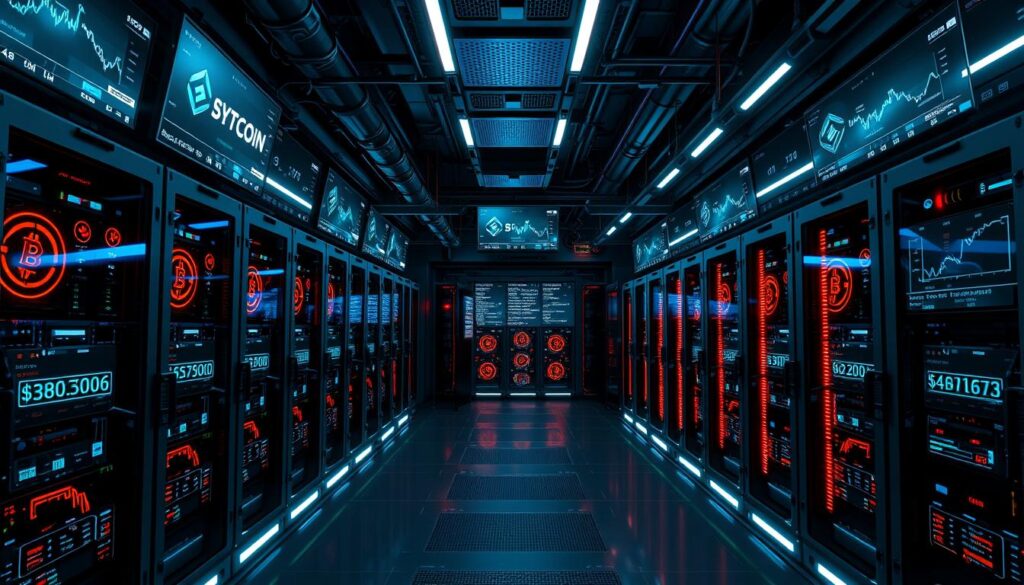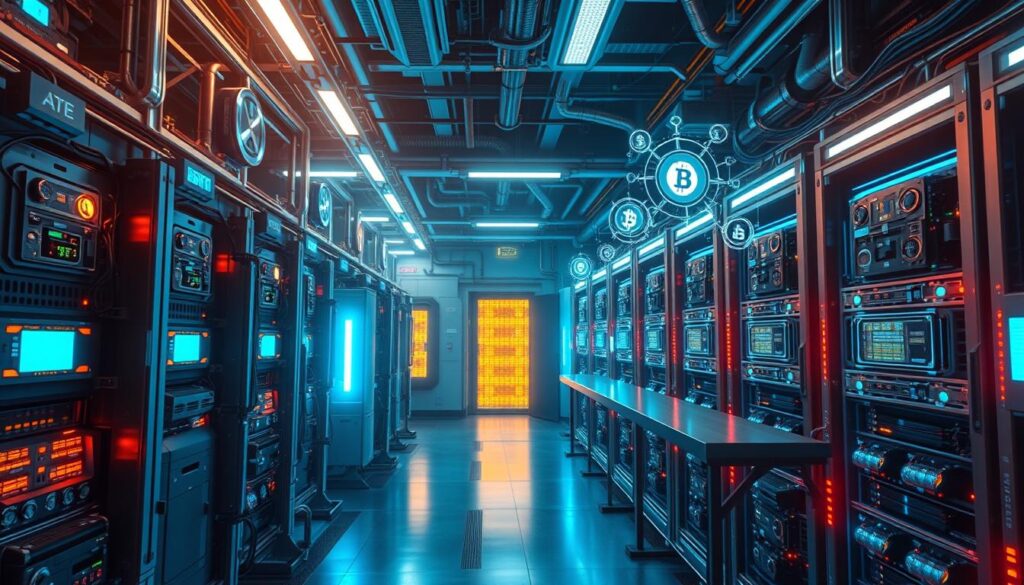The world of cryptocurrency is changing fast, leading to new ideas and challenges. At the center of this change is cryptocurrency mining. It’s key to making sure transactions are safe and the blockchain works right.
As more people want digital money, knowing about crypto mining is key. This is true for both those who invest and those who just like learning about it.

This article will explore crypto mining in depth. We’ll look at how it works, the tech that makes it better, and what it means for the future of digital money. We’ll cover everything from how blockchain checks transactions to the tech and energy needed for mining.
Key Takeaways
- Cryptocurrency mining is the backbone of blockchain technology, validating transactions and securing the network.
- Blockchain uses complex algorithms to validate transactions, with Proof of Work (PoW) and Proof of Stake (PoS) being the two primary consensus mechanisms.
- Mining rewards and incentives play a crucial role in incentivizing miners to contribute to the network and maintain its integrity.
- The evolution of crypto mining technology, from ASICs to GPU rigs, has significant implications for the industry’s future.
- Environmental concerns surrounding the energy consumption of cryptocurrency mining are being addressed through technological advancements and sustainable practices.
Understanding Cryptocurrency Mining Fundamentals
Cryptocurrency mining is key to blockchain technology. It checks transactions, keeps the network safe, and creates new coins. Let’s look at what makes it work.
How Blockchain Validates Transactions
The blockchain is a ledger for all digital currency deals. Blockchain validation makes sure it’s all legit. Miners, with their super computers, solve hard math problems to verify each deal. This keeps the network safe and fair.
Proof of Work vs. Proof of Stake Systems
There are two main ways to agree on deals: Proof of Work (PoW) and Proof of Stake (PoS). In PoW, miners race to solve puzzles. The first one gets crypto mining rewards. PoS, on the other hand, uses how much coin you own to decide who mines.
Mining Rewards and Incentives
Miners get crypto mining rewards for their work. These rewards are new coins and fees from transactions. How much you get depends on the coin, the network’s difficulty, and your power or stake.
Learning about mining helps us understand blockchain better. It shows how complex tech supports digital currencies.
Mining Crypto Technology: Evolution and Innovation
The world of cryptocurrency mining has seen a big change. From using CPUs to now using Application-Specific Integrated Circuits (ASICs), it’s all about getting better. This is all about increased mining efficiency and enhanced crypto mining advancements.
One big change was moving from CPU to GPU mining. Miners wanted to do more work, so they used GPUs. GPUs are better at handling lots of tasks and use less energy than CPUs.
The arrival of ASIC miners was another big step. These chips are made just for mining certain coins. They make mining much faster and more efficient than GPUs.
New technological innovations are coming. Things like using renewable energy and better cooling systems are on the way. These could make mining even better in the future.

The growth of crypto mining tech shows the community’s strength and creativity. Miners keep up with new tech to do better and earn more. The future of mining looks bright, with lots of chances for growth and improvement.
Essential Hardware Requirements for Crypto Mining
Cryptocurrency mining is key to the digital asset world. The right hardware is vital. ASIC miners and GPU rigs are top choices, affecting your mining success.
ASIC Miners vs. GPU Mining Rigs
ASIC miners are made for mining, offering top performance and energy use. They’re the go-to for seasoned miners. GPU rigs, on the other hand, are versatile, working with different mining tasks.
Power Supply Considerations
The power supply is crucial for mining. It must power your hardware well. Look at wattage, efficiency, and connectors to ensure it works right.
Cooling Systems and Maintenance
Mining creates a lot of heat, which can harm your gear. Good cooling systems, like fans or liquid cooling, keep things running smoothly. Regular upkeep, like cleaning and updates, also helps your equipment last longer.
| Feature | ASIC Miners | GPU Rigs |
|---|---|---|
| Performance | Extremely high | High, but variable |
| Energy Efficiency | Highly efficient | Moderately efficient |
| Versatility | Limited to specific algorithms | Adaptable to various algorithms |
| Cost | Typically more expensive | Generally less expensive |
Picking the right mining gear is essential for success. Know the pros and cons of ASIC miners and GPU rigs. Also, focus on power supply and cooling to boost your mining’s efficiency and earnings.
Environmental Impact of Cryptocurrency Mining
Cryptocurrency mining is getting more popular, but it’s harming the environment. The mining process uses lots of energy. This is because it needs powerful computers to solve hard math problems.
Studies show that mining uses about 120 terawatt-hours of energy each year. That’s more than Argentina or Norway use in a year. This high energy use increases the crypto industry’s carbon footprint. It also adds to the global greenhouse gas emissions, making the climate crisis worse.
The crypto mining industry is trying to be more eco-friendly. They are looking into ways to use less energy and reduce their carbon footprint. Some of these efforts include:
- Using renewable energy like solar, wind, or hydropower to power mining
- Creating more energy-efficient mining hardware and software
- Trying out new ways to agree on transactions, like Proof of Stake, which uses less energy
- Creating circular economies where mining waste and heat are reused
The crypto industry needs to keep improving its environmental practices. By using new, green solutions, mining can be made more sustainable. This will help make the future greener for everyone.

| Key Metric | Value |
|---|---|
| Global Energy Consumption of Crypto Mining | 120 TWh per year |
| Equivalent Electricity Consumption of Countries | Argentina or Norway |
| Renewable Energy Initiatives | Solar, wind, hydropower |
| Alternative Consensus Mechanisms | Proof of Stake |
“As the crypto industry continues to evolve, the need for sustainable and environmentally responsible mining practices has become increasingly crucial.”
Mining Pools: Collaborative Crypto Generation
In the world of cryptocurrency mining, pooling resources has become a key strategy. Mining pools combine the efforts of many miners to solve complex problems. They share the rewards based on how much each miner contributed. This teamwork has changed how miners work, opening up new opportunities in the crypto world.
Popular Mining Pool Platforms
The crypto mining scene has grown, with many mining pool platforms emerging. Each offers unique features and benefits to miners. Some well-known platforms include:
- Slush Pool
- AntPool
- F2Pool
- Ethermine
- SparkPool
Pool Fees and Reward Distribution
Mining pool platforms charge a fee, taking a percentage of the rewards. These fees cover costs and motivate pool operators. The way rewards are shared can differ, with some pools using a proportional system and others using other models.
Choosing the Right Mining Pool
Miners should look at a pool’s reputation, fees, reward system, and performance when choosing. By comparing these factors, miners can find the best pool for their goals. This helps them earn consistent rewards through teamwork.
| Mining Pool Platform | Pool Fees | Reward Distribution |
|---|---|---|
| Slush Pool | 2% | Proportional |
| AntPool | 1.5% | Pay-Per-Share |
| F2Pool | 3% | Proportional |
| Ethermine | 1% | Proportional |
| SparkPool | 2.5% | Proportional |
Security Measures in Crypto Mining Operations
In the world of cryptocurrency mining, security is key. It’s vital to protect your mining operations from threats. This keeps your digital assets safe and your network secure. Let’s explore the important steps to secure your mining rigs and wallets.
Fortifying Mining Rigs
Secure mining rigs are the base of a successful mining operation. Use strong physical security like access controls and cameras to keep intruders out. Also, keep your rigs updated with the latest software to avoid vulnerabilities.
Securing Digital Wallets
Digital wallets are a target for hackers. To keep your mining security and wallet protection safe, use hardware wallets. They store your private keys offline, adding extra security. Back up your wallet data and use two-factor authentication to boost cybersecurity.
Safeguarding Network Connections
Protecting your mining operations goes beyond physical and digital security. Make sure your network safety is strong. Use firewalls, VPNs, and watch for any unusual network activity.
By taking these steps, you can safely mine cryptocurrencies. This protects your digital assets and keeps your mining operations running smoothly.
“The security of your mining operations is the foundation upon which your crypto success is built. Invest in robust measures to safeguard your rigs, wallets, and network, and reap the rewards of a well-protected mining infrastructure.”
Profitability Analysis and ROI Calculations
Understanding the profitability of mining cryptocurrencies and calculating ROI is key for miners. This part will look at tools and factors for assessing your mining’s financial success.
Mining Calculator Tools
Many online mining calculators help estimate earnings and ROI. They consider your mining hardware’s hash rate, power use, electricity costs, and the cryptocurrency market. By using these tools, you can see if your mining is profitable and make better investment choices.
Market Volatility Factors
The cryptocurrency market is very volatile, with prices and mining rewards changing often. This volatility affects mining profits. Keeping up with market trends and news helps you adjust to changes, keeping your profits stable.
Operating Costs Breakdown
There are ongoing costs in mining, like electricity, cooling, maintenance, and other expenses. Analyzing these costs helps you understand your mining’s true profit. This knowledge guides decisions on scaling or improving your mining setup.
FAQ
What is cryptocurrency mining?
Cryptocurrency mining is the process of checking and adding transactions to a digital ledger called a blockchain. This is done using powerful computers. Miners get cryptocurrency tokens for their work in keeping the network safe.
How does blockchain validate transactions?
Blockchain uses systems like Proof of Work (PoW) or Proof of Stake (PoS) to check transactions. Miners compete to solve complex puzzles. The first to solve it adds a new block to the chain and gets a reward.
What are the key differences between Proof of Work and Proof of Stake systems?
Proof of Work systems need miners to solve puzzles using lots of computer power. Proof of Stake systems use miners who hold cryptocurrency to validate transactions. PoS is more energy-efficient than PoW.
How do miners earn rewards for their work?
Miners get new cryptocurrency tokens for adding transactions to the blockchain. This reward system encourages miners to use their computer power to keep the network safe.
What are the key advancements in cryptocurrency mining technology?
Mining technology has evolved from CPU to GPU rigs and ASICs. New technologies like liquid cooling and renewable energy are also changing crypto mining.
What are the essential hardware requirements for cryptocurrency mining?
Key hardware includes ASIC miners or GPU rigs, a good power supply, and cooling systems. Keeping your equipment in top shape is important for mining success.
What is the environmental impact of cryptocurrency mining?
Mining is very energy-intensive and can harm the environment. It uses a lot of electricity and creates carbon emissions. There are efforts to use renewable energy and make mining more sustainable.
How do mining pools work, and what are the benefits?
Mining pools combine miners’ power to share rewards. This makes it easier to verify transactions and earn cryptocurrency. Choosing the right pool is important, considering fees and how rewards are distributed.
What security measures should be taken for cryptocurrency mining operations?
Protecting mining rigs, digital wallets, and network connections is vital. Strong security measures and staying alert to threats are key to keeping mining operations safe.
How can miners analyze the profitability and return on investment (ROI) of their mining activities?
Miners use mining calculators to estimate earnings. They consider hardware efficiency, electricity costs, and market changes. Managing expenses well is crucial for making mining profitable.


